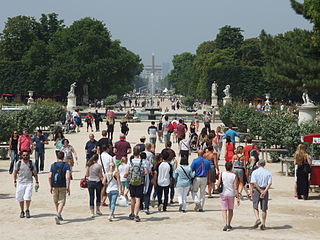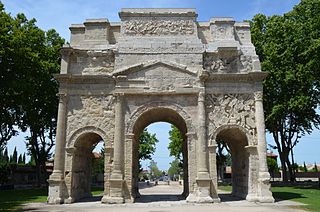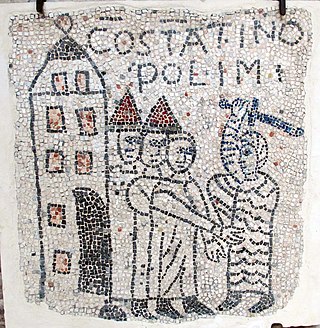
The Arc de Triomphe de l'Étoile, often called simply the Arc de Triomphe, is one of the most famous monuments in Paris, France, standing at the western end of the Champs-Élysées at the centre of Place Charles de Gaulle, formerly named Place de l'Étoile—the étoile or "star" of the juncture formed by its twelve radiating avenues. The location of the arc and the plaza is shared between three arrondissements, 16th, 17th (north), and 8th (east). The Arc de Triomphe honours those who fought and died for France in the French Revolutionary and Napoleonic Wars, with the names of all French victories and generals inscribed on its inner and outer surfaces. Beneath its vault lies the Tomb of the Unknown Soldier from World War I.

Piazza San Marco, often known in English as St Mark's Square, is the principal public square of Venice, Italy, where it is generally known just as la Piazza. The Piazzetta is an extension of the Piazza towards San Marco basin in its southeast corner. The two spaces together form the social, religious and political centre of Venice and are referred to together. This article relates to both of them.

The Tuileries Garden is a public garden between the Louvre and the Place de la Concorde in the 1st arrondissement of Paris, France. Created by Catherine de' Medici as the garden of the Tuileries Palace in 1564, it was opened to the public in 1667 and became a public park after the French Revolution. Since the 19th century, it has been a place for Parisians to celebrate, meet, stroll and relax. During the 2024 Summer Olympics and Paralympics, it was the site of the Olympic and Paralympic cauldron.

The Hippodrome of Constantinople, was a circus that was the sporting and social centre of Constantinople, capital of the Byzantine Empire. Today it is a square in Istanbul, Turkey, known as Sultanahmet Square.

A quadriga is a car or chariot drawn by four horses abreast and favoured for chariot racing in classical antiquity and the Roman Empire. The word derives from the Latin quadrigae, a contraction of quadriiugae, from quadri-: four, and iugum: yoke. In Latin the word quadrigae is almost always used in the plural and usually refers to the team of four horses rather than the chariot they pull. In Greek, a four-horse chariot was known as τέθριππον téthrippon.

A triumphal arch is a free-standing monumental structure in the shape of an archway with one or more arched passageways, often designed to span a road, and usually standing alone, unconnected to other buildings. In its simplest form, a triumphal arch consists of two massive piers connected by an arch, typically crowned with a flat entablature or attic on which a statue might be mounted or which bears commemorative inscriptions. The main structure is often decorated with carvings, sculpted reliefs, and dedications. More elaborate triumphal arches may have multiple archways, or in a tetrapylon, passages leading in four directions.

The Tuileries Palace was a royal and imperial palace in Paris which stood on the right bank of the Seine, directly in the west-front of the Louvre Palace. It was the Parisian residence of most French monarchs, from Henry IV to Napoleon III, until it was burned by the Paris Commune in 1871.

The Arc de Triomphe du Carrousel is a triumphal arch in Paris, located in the Place du Carrousel. It is an example of Neoclassical architecture in the Corinthian order. It was built between 1806 and 1808 to commemorate Napoleon's military victories in the Wars of the Third and Fourth Coalitions. The Arc de Triomphe de l'Étoile, at the far end of the Champs-Élysées, is about twice the size; designed in the same year but not completed until 1836.

The Narva Triumphal Arch was erected in the vast Stachek Square, Saint Petersburg, in 1814 to commemorate the Russian victory over Napoleon.

François-Frédéric Lemot was a French sculptor, working in the Neoclassical style.

The Philadelphion was a public square located in Constantinople.
The Palace of Antiochos was an early 5th-century palace in the Byzantine capital, Constantinople. It has been identified with a palatial structure excavated in the 1940s and 1950s close to the Hippodrome of Constantinople, some of whose remains are still visible today. In the 7th century, a part of the palace was converted into the church–more properly a martyrion, a martyr's shrine–of St Euphemia in the Hippodrome, which survived until the Palaiologan period. Currently a hotel was constructed on top of the ruins but some traces of the palace can be seen under a glass floor at the dining hall.

The Chalke Gate, was the main ceremonial entrance (vestibule) to the Great Palace of Constantinople in the Byzantine period. The name, which means "the Bronze Gate", was given to it either because of the bronze portals or from the gilded bronze tiles used in its roof. The interior was lavishly decorated with marble and mosaics, and the exterior façade featured a number of statues. Most prominent was an icon of Christ which became a major iconodule symbol during the Byzantine Iconoclasm, and a chapel dedicated to the Christ Chalkites was erected in the 10th century next to the gate. The gate itself seems to have been demolished in the 13th century, but the chapel survived until the early 19th century.

The sack of Constantinople occurred in April 1204 and marked the culmination of the Fourth Crusade. Crusaders sacked and destroyed most of Constantinople, the capital of the Byzantine Empire. After the capture of the city, the Latin Empire was established and Baldwin of Flanders crowned as Emperor Baldwin I of Constantinople in Hagia Sophia.

The Place du Carrousel is a public square in the 1st arrondissement of Paris, located at the open end of the courtyard of the Louvre Palace, a space occupied, prior to 1883, by the Tuileries Palace. Sitting directly between the museum and the Tuileries Garden, the Place du Carrousel delineates the eastern end of the gardens just as the Place de la Concorde defines its western end.
Parastaseis syntomoi chronikai is an eighth- to ninth-century Byzantine text that concentrates on brief commentary connected to the topography of Constantinople and its monuments, notably its Classical Greek sculpture, for which it has been mined by art historians.

The Amastrianum, also called Forum Amastrianum by modern authors, was a public square in the city of Constantinople. Used also as place for public mutilations and executions, it disappeared completely after the end of the Byzantine Empire.

Carmagnola or la Carmagnola is the traditional name of a porphyry head of a late Roman emperor, widely thought to represent Justinian, now placed on the external balustrade of St Mark's Basilica in Venice.

The Treasury of St Mark's Basilica contains the church treasure or collection of sacred objects and reliquaries kept in St Mark's Basilica in Venice, Italy. The treasure constitutes the single best collection of Byzantine metalwork and enamels that survives, many of the items having been looted during the Fourth Crusade of 1204. The treasury also contains some significant artworks made for the basilica itself, but no longer used there.

The Return of the Horses of San Marco is an 1815 history painting by the Italian artist Vincenzo Chilone. It depicts the return of the Horses of Saint Mark to the city of Venice the same year. The four bronze statues dated back to classical antiquity and had been in Venice since 1204. In 1797 Napoleon invaded and dissolved the Republic of Venice, taking the Horses of Saint Mark as war booty to France. From 1807 they were displayed on top of the new Arc de Triomphe du Carrousel in Paris.





























